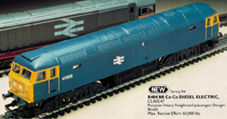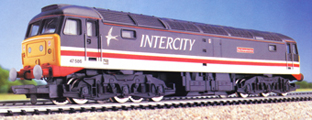Locomotive Class
Class 47 (Type 4)
 Class: Class 47 (Type 4)
Class: Class 47 (Type 4)
Type: Diesel-Electric
Designer: Brush
Weight: 117 tons
Purpose: Heavy Freight & Express Passenger
Information: Originally classified as Type 4 locomotives and later re-classified under the TOPS system as Class 47; the locomotives were introduced in 1962 with variants of the class still operational today (2010).
Details: Originally classified by British Railways as Type 4 diesel electric locomotives; in 1962 as part of the British Railways modernization plan, these locomotives were key elements in the plan put forth by the British Transport Commission to completely replace steam traction through-out the system by 1968. To optimize class availability a high power, light axle weight design was incorporated for both passenger and freight operations.
Two prototypes were built for assessment; the first D0260 Lion, produced by AEI and BRC&W using a Sulzer engine, whilst in comparison a second unit, D0280 Falcon was built by Brush Traction, utilizing a Maybach engine. Because of the short time involved to build a large fleet; significant testing was not conducted, but the apparent early success of Lion prompted the decision to stay with the Sulzer motive power.
Eventually, 512-locomotives were built. They were constructed jointly between BRC&W in Crewe and Brush Traction in Loughborough. Many early locomotives were equipped with steam heat apparatus for passenger coach heating. In later years these were replaced with electric heating units.
The TOPS numbering system reclassified the locomotive and numbering system from 1972. With the introduction of the TOPS system differences between class members were easier to keep a track of. As such, many locomotives were reclassified and renumbered over their long life-spans.
Through the years the class has seen a wide variety of colourful liveries. Originally introduced in dual-tone green; this gave way to corporate blue by the late 1960ís. By the early 1980ís a sense of individuality returned as units were repainted in a wide variety of British Railway sector liveries. In turn these gave way to an even wider and more varied spectrum of colours as used by the Private Owner Companies after 1995.
The class was extremely successful and locomotives were used through-out Britain on all regions. After 20-years of service; by 1985 only 5-members had been with-drawn, all due to accident damage. After this time the locomotives work was declining, or in a state of change. High Speed Trains were taking over mainline passenger duties and steam heated stock was being disposed of at an alarming rate. Although being continually up-dated to reflect the modern motive power scene; the use of a double ended versatile freight / passenger diesel was now becoming some-what limited. After 1985 the original 20 units were with-drawn as non-standard. After that, units not recently having a major over-haul became easy targets for withdrawal.
Between 1997 and 2004; 33-members of the class were completely refurbished with General Motors drive units for hauling both mainline passenger and freight for their private operator owners. Interestingly, the Class 57 was built to compete with the newly introduced class 66, itself part of the plan to replace the ageing fleet of Class 47ís. As of 2009, 37 units were allocated to private ownership and heritage railways with a hand-full of original Class 47ís still in daily operation. As interest in early diesels becomes increasingly popular, the Class 47 will no doubt be with us for many years to come.Originally classified by British Railways as Type 4 diesel electric locomotives; in 1962 as part of the British Railways modernization plan, these locomotives were key elements in the plan put forth by the British Transport Commission to completely replace steam traction through-out the system by 1968. To optimize class availability a high power, light axle weight design was incorporated for both passenger and freight operations.
Two prototypes were built for assessment; the first D0260 Lion, produced by AEI and BRC&W using a Sulzer engine, whilst in comparison a second unit, D0280 Falcon was built by Brush Traction, utilizing a Maybach engine. Because of the short time involved to build a large fleet; significant testing was not conducted, but the apparent early success of Lion prompted the decision to stay with the Sulzer motive power.
Eventually, 512-locomotives were built. They were constructed jointly between BRC&W in Crewe and Brush Traction in Loughborough. Many early locomotives were equipped with steam heat apparatus for passenger coach heating. In later years these were replaced with electric heating units.
The TOPS numbering system reclassified the locomotive and numbering system from 1972. With the introduction of the TOPS system differences between class members were easier to keep a track of. As such, many locomotives were reclassified and renumbered over their long life-spans.
Through the years the class has seen a wide variety of colourful liveries. Originally introduced in dual-tone green; this gave way to corporate blue by the late 1960ís. By the early 1980ís a sense of individuality returned as units were repainted in a wide variety of British Railway sector liveries. In turn these gave way to an even wider and more varied spectrum of colours as used by the Private Owner Companies after 1995.
The class was extremely successful and locomotives were used through-out Britain on all regions. After 20-years of service; by 1985 only 5-members had been with-drawn, all due to accident damage. After this time the locomotives work was declining, or in a state of change. High Speed Trains were taking over mainline passenger duties and steam heated stock was being disposed of at an alarming rate. Although being continually up-dated to reflect the modern motive power scene; the use of a double ended versatile freight / passenger diesel was now becoming some-what limited. After 1985 the original 20 units were with-drawn as non-standard. After that, units not recently having a major over-haul became easy targets for withdrawal.
Between 1997 and 2004; 33-members of the class were completely refurbished with General Motors drive units for hauling both mainline passenger and freight for their private operator owners. Interestingly, the Class 57 was built to compete with the newly introduced class 66, itself part of the plan to replace the ageing fleet of Class 47ís. As of 2009, 37 units were allocated to private ownership and heritage railways with a hand-full of original Class 47ís still in daily operation. As interest in early diesels becomes increasingly popular, the Class 47 will no doubt be with us for many years to come.
John Faulkner
Class 47 (Type 4) Releases (45)
Class 47 (Type 4) Images (45)

B.R. Freightliner Locomotive with Three Container Wagons (Class 47) 47345

Class 47 (Type 4) Co-Co Locomotive 47421

Class 47 (Type 4) Co-Co Locomotive D1520

Class 47 (Type 4) Co-Co Locomotive D1738

Class 47 (Type 4) Co-Co Locomotive - Mammoth D1670

Class 47 Co-Co Diesel Electric Locomotive 47784

Class 47 Co-Co Diesel Electric Locomotive 47854

Class 47 Co-Co Diesel Electric Locomotive - Carn Peak 47316

Class 47 Co-Co Diesel Electric Locomotive - The Fosse Way 47200

Class 47 Co-Co Diesel Locomotive 47808

Class 47 Co-Co Diesel Locomotive - James Nightall G.C. 47579

Class 47 Co-Co Locomotive 47568

Class 47 Co-Co Locomotive 47487

Class 47 Co-Co Locomotive 47409

Class 47 Co-Co Locomotive 47378

Class 47 Co-Co Locomotive - County Of Norfolk 47170

Class 47 Co-Co Locomotive - Lady Diana Spencer 47712


Class 47 Co-Co Locomotive - North Star 47613

Class 47 Co-Co Locomotive - Northamptonshire 47586

Class 47 Co-Co Locomotive - Rail Riders 47406

Class 47 Co-Co Locomotive - The London Standard 47573

Class 47 Co-Co Locomotive - The Queen Mother 47541

Class 47 Co-Co Locomotive - The Silcock Express 47231

Class 47 Co-Co Locomotive - Tunnel 47234

Class 47 Co-Co Locomotives - Greyfriars Bobby & The Duke Of Edinburghs Award 47716 47711

Class 47 Diesel Electric Locomotive 47844

Class 47 Diesel Electric Locomotive 47237

Class 47 Diesel Electric Locomotive 47839

Class 47 Diesel Electric Locomotive 47853

Class 47 Diesel Electric Locomotive (Weathered) 47120

Class 47 Diesel Electric Locomotive (Weathered) 47432

Class 47 Diesel Electric Locomotive (Weathered) 47473

Class 47 Diesel Electric Locomotive - Bristol Bath Road 47816

Class 47 Diesel Electric Locomotive - Dionysos 47709

Class 47 Diesel Electric Locomotive - Freightliner 1995 47376

Class 47 Diesel Electric Locomotive - Pride of Shrewsbury 47822

Class 47 Diesel Electric Locomotive - Pride Of Toton 47805

Class 47 Diesel Electric Locomotive - Resilient 47741

Class 47 Diesel Electric Locomotive - Spirit Of Chester 47841

Class 47 Diesel Electric Locomotive - The Lion Of Vienna 47807

Class 47 Diesel Electric Locomotive - The Queen Mother 47722

Class 47 Diesel Electric Locomotive - Womens Royal Voluntary Service 47854

Class 47 Diesel Locomotive 47079

Class 47 Diesel Locomotive 47844

Serco Railtest Train Pack (Class 47 - Isle Of Iona) 47781

















